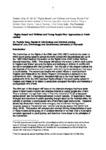‘Rights-Based’ and ‘Children and Young People First’ Approaches to Youth Justice
| dc.contributor.author | Gray, Patricia | |
| dc.contributor.editor | Pamela Ugwudike, Hannah Graham, Fergus McNeill, Peter Raynor, Faye S Taxman, Chris Trotter | |
| dc.date.accessioned | 2019-11-08T14:40:01Z | |
| dc.date.available | 2019-11-08T14:40:01Z | |
| dc.date.issued | 2019 | |
| dc.identifier.isbn | 9781138102057 | |
| dc.identifier.other | 60 | |
| dc.identifier.uri | http://hdl.handle.net/10026.1/15127 | |
| dc.description.abstract |
The Committee on the Rights of the Child (see CRC, 2007) monitors the extent to which youth justice systems across the world comply with the principles laid out in the 1989 United Nations Convention on the Rights of the Child (United Nations General Assembly, 1989). This chapter will explore the extent to which youth justice in England and Wales protects the rights and wellbeing of children in conflict with the law in compliance with the Convention. The first part of this chapter outlines the key features of International and European children’s rights standards as they apply to youth justice. The second part begins with a brief history of youth justice in England and Wales since the United Kingdom (UK) became a signatory to the Convention in 1991. Throughout this period right up to the most recent report published in 2016, the CRC has been highly critical of the youth justice system in England and Wales for its failure to adequately safeguard the rights and wellbeing of young people who offend. The third part of this chapter will focus on the dramatic changes that have taken place in recent years in policy and practice directed at young people who offend. This is reflected in a significant drop in ‘first time entrants’ (FTEs) to the youth justice system and the numbers sentenced to youth custody. In response to these changes and reductions in public spending brought about by the financial crisis, the delivery of services to young people who offend have been restructured. Research shows that three main models have emerged, that is ‘offender management’, ‘targeted specialist intervention’ and ‘children and young people first’ (Smith and Gray, 2018). This section will compare and contrast the key characteristics of each of these models before going on to consider whether or not they offer a more rights compliant approach to youth justice, and therefore move closer to the principles of the Convention. The final part of this chapter will focus specifically on youth offending services that follow a ‘children and young people first’ (CYPF) model. Such services claim to pursue a distinctly different, ‘child-friendly’ and progressive attitude to youth justice which is explicitly guided by the 1989 Convention. In this section it will be argued that while youth justice agencies which adopt a CYPF approach do indeed offer a more rights-compliant approach, the extent to which such agencies fully uphold the principles of the Convention in the sense of addressing young people’s social welfare rights based on social justice principles is questionable. | |
| dc.format.extent | 743-754 | |
| dc.language.iso | en | |
| dc.publisher | Routledge | |
| dc.relation.ispartof | The Routledge Companion to Rehabilitative Work in Criminal Justice | |
| dc.title | ‘Rights-Based’ and ‘Children and Young People First’ Approaches to Youth Justice | |
| dc.type | chapter | |
| plymouth.publication-status | Published | |
| plymouth.organisational-group | /Plymouth | |
| plymouth.organisational-group | /Plymouth/Faculty of Arts, Humanities and Business | |
| plymouth.organisational-group | /Plymouth/Faculty of Arts, Humanities and Business/School of Society and Culture | |
| plymouth.organisational-group | /Plymouth/Research Groups | |
| plymouth.organisational-group | /Plymouth/Research Groups/Institute of Health and Community | |
| plymouth.organisational-group | /Plymouth/Users by role | |
| dc.publisher.place | London | |
| dc.rights.embargoperiod | Not known | |
| rioxxterms.licenseref.uri | http://www.rioxx.net/licenses/all-rights-reserved | |
| rioxxterms.type | Book chapter |


